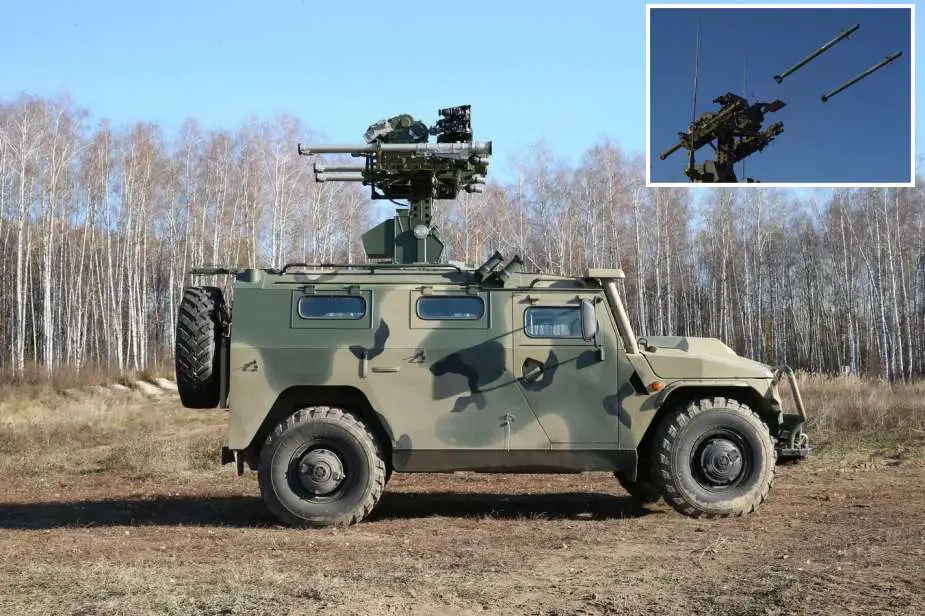Russian Gibka-S Air Defense System undergoes evaluation on Ukraine frontline
According to reports from Russian media, the Gibka-S, a short-range surface-to-air missile system (SAM) developed by the JSC Machine Building Design Bureau, has been deployed and is currently being evaluated in Ukraine. Rostec, in an interview, discussed the feedback received from the system's deployment and confirmed their ongoing technical support for these SAMs, with teams visiting the Ukrainian frontline for assistance.
Follow Army Recognition on Google News at this link

Russian Gibka-S Air Defense System undergoes evaluation on Ukraine frontline (Picture source JSC Corporation and Yandex)
The Gibka-S system has been integrated into a Tigr-M vehicle and is designed to counter various aerial threats, including airplanes, helicopters, unmanned aerial vehicles, cruise missiles, and high-precision weapon systems. It is designed to address threats at low and extremely low altitudes, regardless of the time of day or visibility conditions. The system is equipped with four missiles, with options such as the Igla, Igla-S, or Verba missile.
The Gibsta-S is equipped with a total of 8 missiles, divided into two sections for practical deployment. It is designed with three firing channels, offering flexibility for various combat scenarios. The system can operate autonomously or be directed by a higher command post, adapting as required by the mission. The crew comprises three members: a squad commander, two anti-aircraft gunners, and a driver-electrician. Notably, the launch-guidance unit can hold 4 missiles, with an additional 4 missiles stored for swift readiness. Moreover, the launch-guidance unit holds 1 missile, and two anti-aircraft gunners are stationed externally, ensuring rapid response capabilities even outside the combat vehicle's enclosure.
The Tigr-M is a variant of the standard Russian 4x4 light tactical vehicle Tigr. It is manufactured by the Russian Defense Company Arzamas Machinery-Plant and has the capacity to transport up to 10 infantry personnel. It functions as both an armored personnel carrier and a cargo vehicle. The Tigr-M is powered by a Russian-made YaMZ-5347-10 diesel engine, capable of reaching a maximum speed of up to 140 km/h and covering an operational range of 1,000 km. It is also equipped with a central tire inflation system and an engine compartment fire extinguishing system.
The 9K38 Igla (SA-18 Grouse) is a man-portable air-defense system (MANPADS) originating from the Soviet Union. Introduced into service in 1981, it incorporates a dual waveband infra-red guidance system. The missile has a weight of 10.8 kg and boasts operational ranges that vary across its versions: Igla-1 with a range of 5.0 km, Igla with 5.2 km, and the SA-24 Igla-S extending up to 6.0 km. It is capable of targeting aircraft flying at speeds of up to 570 m/s and reaching a flight ceiling of 3.5 km.
The 9K333 Verba represents the fourth generation of Russian MANPADS and was introduced into service in 2014. With a weight of 17.25 kg, the Verba missile is distinctively equipped with a three-channel optical seeker, functioning in ultraviolet, near-infrared, and mid-infrared spectra. This advanced seeker enhances the Verba's ability to differentiate between actual targets and decoys, minimizing susceptibility to countermeasures. The missile can effectively engage targets flying at speeds of up to 500 m/s. It offers an operational range of 500m to 6,500m and can target aircraft at altitudes ranging from 10m to 4.5km.
Testing new military equipment, such as the Gibka-S, in real combat operations before mass production is a standard procedure in military development. While laboratory and controlled environment tests provide initial data about a system's capabilities, real combat scenarios offer a different set of conditions that the equipment might face. Field testing under these conditions can reveal how the equipment functions under various combat stresses.
In these real-world conditions, potential vulnerabilities or flaws in the equipment might emerge. These could relate to durability, functionality, or user interface. Identifying these issues before mass production allows for modifications, ensuring that the equipment meets the required standards. Additionally, feedback from soldiers and operators who use the equipment in combat can be used to refine its design and functionality.
From an economic perspective, addressing issues before large-scale manufacturing can be more cost-effective than post-production modifications. Moreover, testing in combat scenarios provides data on how the new equipment integrates with existing military tactics and strategies. This can inform any necessary tactical adjustments.
Soldiers' trust in their equipment is essential for operational effectiveness. Knowing that their equipment has undergone testing in combat scenarios can influence their trust levels. Combat testing also allows for a comparison between the new equipment and existing or opposing forces' equipment, providing a clearer understanding of its capabilities. Finally, in combat, new equipment will often need to operate in conjunction with other systems, whether they are communication tools, other weapons, or vehicles. Testing ensures that the new equipment is compatible with these systems, ensuring smooth operations in the field.




























